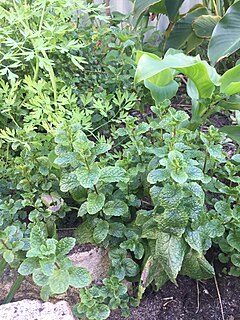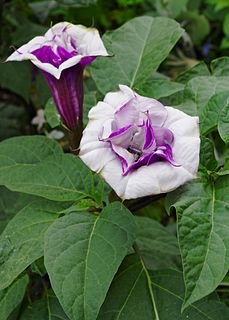
Muti is a term for traditional medicine in Southern Africa as far north as Lake Tanganyika. In South African English, the word "muti" is derived from the Zulu word umuthi, meaning "tree," whose root is -thi. In Southern Africa, "muti" and cognates of umuthi are in widespread use in most indigenous African languages as well as in South African English and Afrikaans, which sometimes use "muti" as a slang word for medicine in general.

Bach flower remedies (BFRs) are solutions of brandy and water—the water containing extreme dilutions of flower material developed by Edward Bach, an English homeopath, in the 1930s. Bach claimed that dew found on flower petals retain imagined healing properties of that plant. Systematic reviews of clinical trials of Bach flower solutions have found no efficacy beyond a placebo effect.

Traditional healers of South Africa are practitioners of traditional African medicine in Southern Africa. They fulfill different social and political roles in the community, including divination, healing physical, emotional and spiritual illnesses, directing birth or death rituals, finding lost cattle, protecting warriors, counteracting witchcraft, and narrating the history, cosmology, and myths of their tradition. There are two main types of traditional healers within the Nguni, Sotho-Tswana, and Tsonga societies of Southern Africa: the diviner (sangoma), and the herbalist (inyanga). These healers are effectively South African shamans who are highly revered and respected in a society where illness is thought to be caused by witchcraft, pollution or through neglect of the ancestors. It is estimated that there are as many as 200,000 indigenous traditional healers in South Africa compared to 25,000 Western-trained doctors. Traditional healers are consulted by approximately 60% of the South African population, usually in conjunction with modern biomedical services.
Herbalism is the study of botany and use of plants intended for medicinal purposes. Plants have been the basis for medical treatments through much of human history, and such traditional medicine is still widely practiced today. Modern medicine makes use of many plant-derived compounds as the basis for evidence-based pharmaceutical drugs. Although herbalism may apply modern standards of effectiveness testing to herbs and medicines derived from natural sources, few high-quality clinical trials and standards for purity or dosage exist. The scope of herbal medicine is sometimes extended to include fungal and bee products, as well as minerals, shells and certain animal parts.

Traditional medicine comprises medical aspects of traditional knowledge that developed over generations within various societies before the era of modern medicine. The World Health Organization (WHO) defines traditional medicine as "the sum total of the knowledge, skills, and practices based on the theories, beliefs, and experiences indigenous to different cultures, whether explicable or not, used in the maintenance of health as well as in the prevention, diagnosis, improvement or treatment of physical and mental illness". Traditional medicine is contrasted with scientific medicine.

Ethnobotany is the study of a region's plants and their practical uses through the traditional knowledge of a local culture and people. An ethnobotanist thus strives to document the local customs involving the practical uses of local flora for many aspects of life, such as plants as medicines, foods, and clothing. Richard Evans Schultes, often referred to as the "father of ethnobotany", explained the discipline in this way:
Ethnobotany simply means ... investigating plants used by societies in various parts of the world.
Energy medicine, energy therapy, energy healing, vibrational medicine, psychic healing, spiritual medicine or spiritual healing are branches of alternative medicine based on a pseudo-scientific belief that healers can channel healing energy into a patient and effect positive results. This idea itself contains several methods: hands-on, hands-off, and distant where the patient and healer are in different locations.

Health and medicine among the ancient Maya was a complex blend of mind, body, religion, ritual and science. Important to all, medicine was practiced only by a select few, who generally inherited their positions and received extensive education. These shamans acted as a medium between the physical world and spirit world. They practiced sorcery for the purpose of healing, foresight, and control over natural events. Since medicine was so closely related to religion, it was essential that Maya medicine men had vast medical knowledge and skill. It is known that the Maya sutured wounds with human hair, reduced fractures, and were even skilled dental surgeons, making prostheses from jade and turquoise and filling teeth with iron pyrite.
Bush medicine, also called traditional medicine, is the sum of the total knowledge, skills and practices based on the theories, beliefs and experiences indigenous to different cultures, whether explicable or not, used in the maintenance of health as well as in the prevention, diagnosis, improvement or treatment of physical and mental illness. Bush medicine is also connected to the holistic worldview in such a way that the interplay between the physical, emotional, social and spiritual aspects is crucial in attaining wellbeing.
Vlakplaas is a farm 20 km west of Pretoria that served as the headquarters of the South African Police counterinsurgency unit C10 working for the apartheid government in South Africa. The C-designation of the counterinsurgency unit was its official name but the whole unit became known as Vlakplaas and was commanded first by Dirk Coetzee and then Eugene de Kock.
Hebanthe eriantha is a species of plant in the Amaranthaceae family.

The Tree of physiology is a Tibetan Thangka depicting human physiology and certain pathological transformations.

Prehistoric medicine is any use of medicine from before the invention of writing and the documented history of medicine. Because the timing of the invention of writing varies per culture and region, the term "prehistoric medicine" encompasses a wide range of time periods and dates.
Yorùbá medicine, or egbo'gi, is an African system of herbalism and phytotherapy practised primarily in West Africa and the Caribbean.
"African herbal medicine is commonly called Yorubic or Orisha medicine on the African continent. It started from a religious text, called Ifa Corpus. According to tradition, the Ifa Corpus was revealed by the mystic prophet, Orunmilla, around 4,000 years ago in the ancient city of Ile-Ife, now known as major city in Yorùbáland. The last 400 years saw individuals in the Caribbean and South America practice the Yorubic healing system as a token of their past when the first wave of Stolen Africans arrived in the Americas."

In general use, herbs are plants with savory or aromatic properties that are used for flavoring and garnishing food, medicinal purposes, or for fragrances; excluding vegetables and other plants consumed for macronutrients. Culinary use typically distinguishes herbs from spices. Herbs generally refers to the leafy green or flowering parts of a plant, while spices are usually dried and produced from other parts of the plant, including seeds, bark, roots and fruits.

Traditional African medicine is an alternative medicine discipline involving indigenous herbalism and African spirituality, typically involving diviners, midwives, and herbalists. Practitioners of traditional African medicine claim to be able to cure various and diverse conditions such as cancers, psychiatric disorders, high blood pressure, cholera, most venereal diseases, epilepsy, asthma, eczema, fever, anxiety, depression, benign prostatic hyperplasia, urinary tract infections, gout, and healing of wounds and burns and even Ebola.
Navajo medicine today has remained preserved for millennia as many Navajo people have relied on traditional medicinal practices as their primary source of healing. However, modern day residents within the Navajo Nation have incorporated contemporary medicine into their society with the establishment of Western hospitals and clinics on the reservation over the last century.
The Hausa people are an African tribe originating from what is modern-day Nigeria. Their medicine is heavily characterized by Islamic influence from the East as well as traditional, African-style herbology, and religious practices which are still prevalent today. Many traditional healing methods such as religious and spiritual healing are often used alongside more modern scientific medicine among Hausa villages and cities.

Chumash traditional medicine is a type of traditional medicine practiced by the Chumash people of the southern coastal regions of California.













